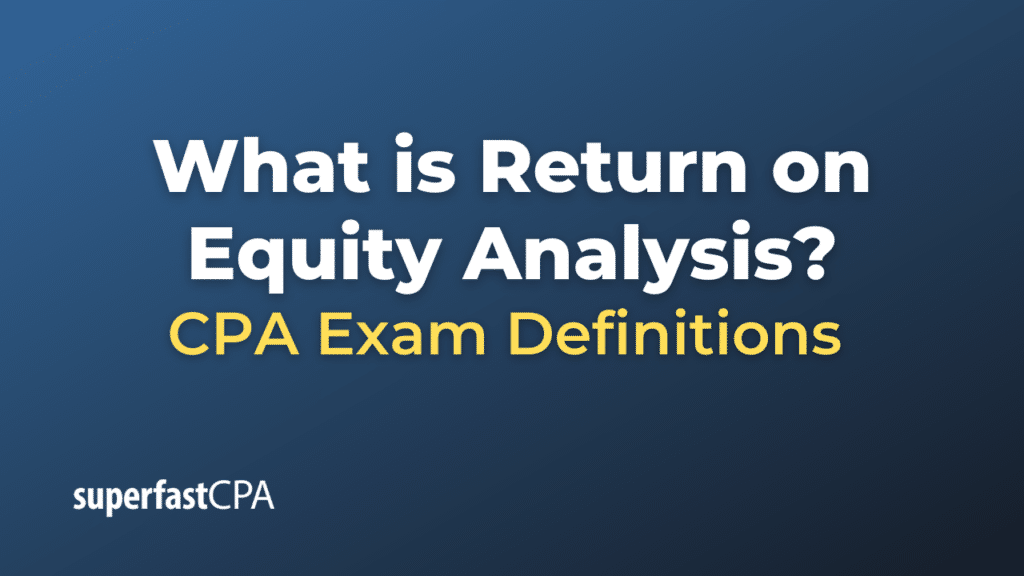Return on Equity Analysis
Return on Equity (ROE) analysis is a method used by investors and analysts to evaluate a company’s ability to generate profits from its shareholders’ equity. Essentially, ROE measures the profit a company produces from the money investors have put into it.
ROE is calculated using the formula:
ROE = Net Income / Shareholders’ Equity
ROE analysis involves interpreting the ROE ratio and comparing it to other companies in the same industry, the company’s historical ROEs, and other relevant benchmarks to assess the company’s financial performance.
Here’s why ROE analysis is important:
- Efficiency of equity Use: A high ROE indicates that a company is using its shareholders’ equity effectively to generate profits. This suggests that the company’s management is efficient at deploying capital.
- Growth Potential: Companies with consistently high ROE may have more sustainable growth since they are able to reinvest earnings more effectively.
- Financial Leverage: ROE can also reflect the level of financial leverage a company has. Companies with higher debt might have higher ROEs due to the leveraging effect, but this also comes with higher risks.
- Comparison with Peers: ROE is a common metric used to compare the profitability of companies in the same industry. By benchmarking a company’s ROE against its peers, analysts can determine how well the company is performing in the context of its industry.
- Decomposition with DuPont Analysis: To further understand the components driving ROE, analysts often use the DuPont analysis. This breaks down ROE into three components: Profit Margin, Asset Turnover, and Equity Multiplier. By examining each factor, analysts can pinpoint the sources of a company’s profitability or lack thereof.
ROE = Net Profit Margin × Asset Turnover × Equity Multiplier
Where:
- Net Profit Margin = Net Income / Sales
- Asset Turnover = Sales / Total Assets
- Equity Multiplier = Total Assets / Shareholders’ Equity
By breaking down ROE using the DuPont analysis, it becomes clear which operational metrics are driving the company’s equity efficiency.
In summary, ROE analysis is a crucial tool for investors and analysts looking to understand a company’s profitability, growth potential, and the efficiency with which its management uses shareholders’ equity. It’s always important to consider ROE in the context of industry norms, levels of financial risk, and broader economic conditions.
Example of Return on Equity Analysis
Let’s use a fictional company, ABC Corp, to illustrate ROE and DuPont analysis:
Company ABC Corp Financials:
- Net Income: $500,000
- Sales (Revenue): $2,500,000
- Total Assets: $3,000,000
- Shareholders’ Equity: $2,000,000
Step 1: Calculate ROE:
ROE = Net Income / Shareholders’ Equity
ROE = $500,000 / $2,000,000
ROE = 0.25
Expressed as a percentage, ABC Corp’s ROE is 25%.
Step 2: DuPont Analysis:
Net Profit Margin = Net Income / Sales
Net Profit Margin = $500,000 / $2,500,000 = 0.20
Expressed as a percentage, the Net Profit Margin is 20%.
- Asset Turnover:
Asset Turnover = Sales / Total Assets
Asset Turnover = $2,500,000 / $3,000,000 = 0.833
This means that for every dollar in assets, ABC Corp generates $0.833 in sales.
- Equity Multiplier:
Equity Multiplier = Total Assets / Shareholders’ Equity
Equity Multiplier = $3,000,000 / $2,000,000 = 1.5
This means ABC Corp has $1.5 of assets for every dollar of shareholders’ equity.
Step 3: Confirm ROE with DuPont:
ROE = Net Profit Margin × Asset Turnover × Equity Multiplier
ROE = 0.20 × 0.833 × 1.5 = 0.25
This confirms our earlier calculation that ABC Corp’s ROE is 25%.
Analysis:
- With an ROE of 25%, ABC Corp is effectively using its shareholders’ equity to generate profits.
- The DuPont breakdown reveals that their solid ROE is driven by a good net profit margin of 20%. Their asset turnover is reasonable, suggesting moderate efficiency in using assets to generate sales. The equity multiplier indicates a moderate level of leverage.
By conducting this analysis, not only do we understand ABC Corp’s profitability from its equity (ROE), but we also have insights into how its operational efficiency, asset utilization, and leverage contribute to that ROE.












